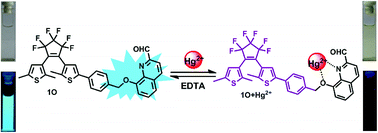A colorimetric and fluorescent chemosensor for Hg2+ based on a photochromic diarylethene with a quinoline unit
Abstract
A new colorimetric and fluorescent ‘on–off’ chemosensor, 1O, based on a photochromic diarylethene with a quinoline unit was designed and synthesized. The chemosensor 1O demonstrated selective and sensitive detection of Hg2+ ions in the presence of other competitive metal ions in acetonitrile. The stoichiometric ratio of the sensor 1O for Hg2+ was determined to be 1 : 1, and the limit of detection of the probe 1O was calculated to be 56.3 nM for Hg2+. In addition, a molecular logic circuit with four inputs and one output was successfully constructed with UV/vis light and metal-responsive behavior. ESI-MS spectroscopy, Job's plot analysis, and 1H NMR titration experiments confirm the binding behavior between 1O and Hg2+.



 Please wait while we load your content...
Please wait while we load your content...